Making a flourless chocolate cake
This cake is a prime example of Joe Pastry’s Inverse Law of Ingredient Dynamics, which states that as the number of ingredients in a given recipe goes down, the importance of the quality of those ingredients and the techniques by which they are handled goes up. There’s a great misconception out there that because a flourless cake isn’t leavened, it’s basically fool-proof. However as all of us who’ve eaten chalky homemade flourless cakes can attest, they can be, and usually are, messed up. Thus it’s important to pay attention to the details.
So then, first thing is to get the oven on to 325. Set a large pot of water simmering for your water bath, and turn the heat on under your double boiler. Then, beginning with whatever blend of semi- and extra-bittersweet chocolates you wish, lay them down on your cutting board…
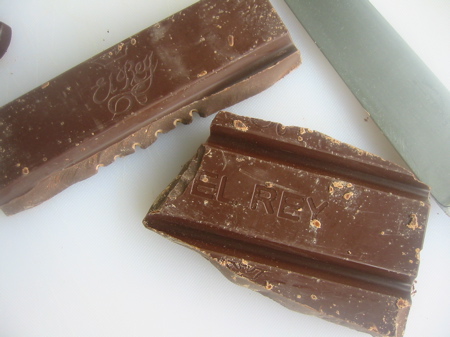
…and with the biggest, heaviest chef’s knife you own, carefully chop it.
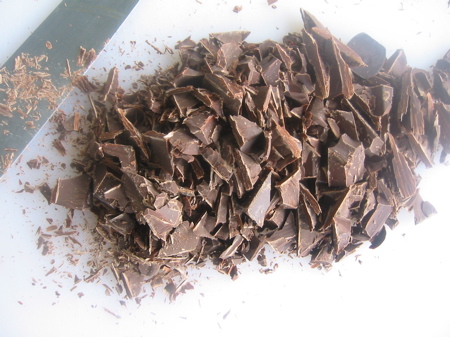
Next, get your cake pan ready for its nice warm bath. Prepare your 9″ springform pan (instructions are over to the right). Lay it on a sheet of tin foil, gather the foil up around the sides, and press it to form. This is where the double-width foil of a professional kitchen comes in very handy, but I don’t keep a two-ton roll like that hanging around (at least not anymore).
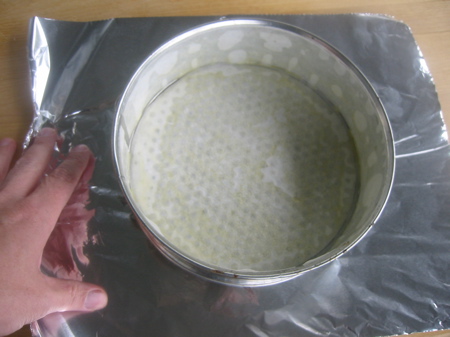
You want the foil to come at least half way up all sides of the pan like so:
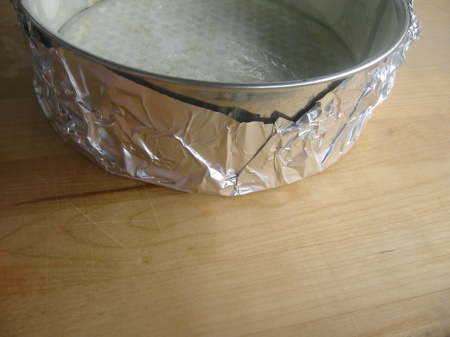
What you’re making is essentially a little boat. Now then, put your eggs in the bowl of a mixer fitted with a whip and turn the mixer on medium-high (this is one instance where your eggs don’t need to be at room temperature…in fact cold eggs are preferred since they whip up into a “finer” foam).
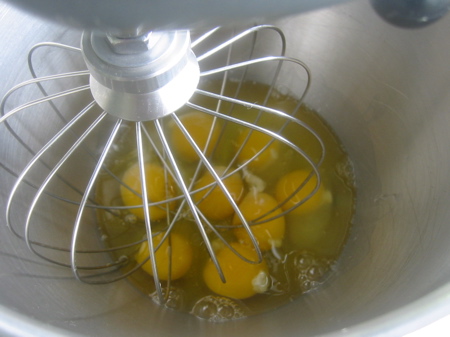
While the machine is running, put your butter and chocolate in the double boiler (yes that’s expensive Euro-butter…remember what I said about ingredients?). Very gently melt them together. It should take about ten minutes.

…by which time your eggs should be very foamy and light, several times their original volume. About like so:

Now all you need to do is combine them, but gently since those bubbles are all the leavening this cake will have. Thus you’ll want to fold them in (instructions for that are also over there on the right). Since the mixture needs to be lightened before real folding can happened, begin by adding a third of the egg foam…

…and simply stirring it in until it looks like so:

Streaks are OK. So then, add another third…
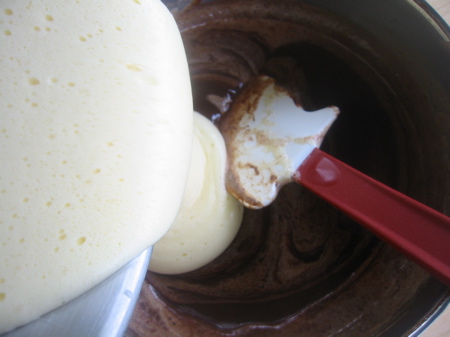
…and this time fold like you mean it. Until it looks like so:
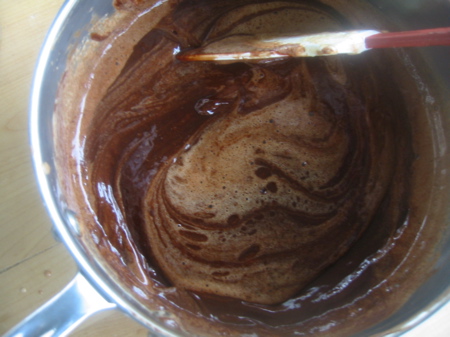
Add the last of the egg…

…and keep folding diligently until just a few streaks remain.

Pour your batter into your prepared pan/boat…
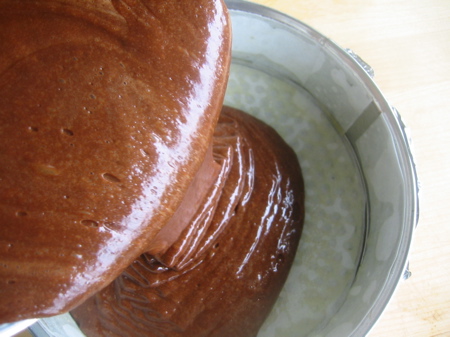
…and insert it into your expensive Continental bain marie. Mine I have cleverly disguised as a cheap speckled tin roasting pan, so as not to make all of you feel inadequate.
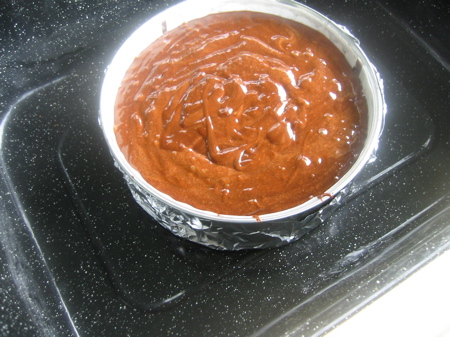
Add your hot water, enough to come half way up the side of the cake pan.
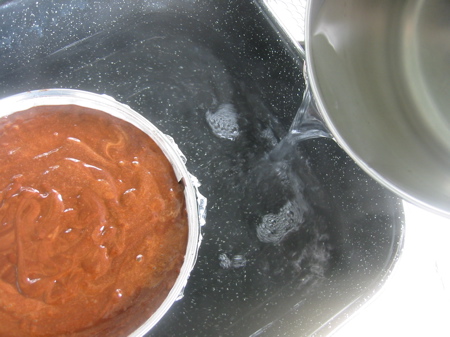
Carefully insert the whole thing into your oven on the bottom rack (alternately, you can wait to fill the water bath until after it’s in the oven). Bake at 325. I set my thermometer for fifteen minutes, then check the temperature every five or so minutes afterward to make sure I don’t overshoot my target temperature of 140 degrees. A digital thermometer comes in very, very handy for this.
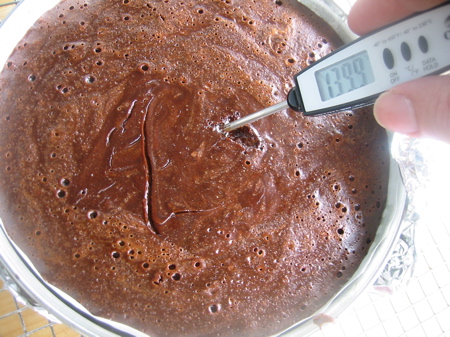
Ah yes, there we go, right about 140. You’ll notice that the cake is still very pudding-like in the middle at this point. Never fear, it will firm. Remove it from the water bath and place it on a rack to cool. Once it’s cooled down to room temperature, place it in the fridge to chill overnight.
Hey, Joe – would anything structural fail for this cake if I were to substitute full-fat margarine for butter? I know for sure the taste will be affected, but I’d like to make it for someone who’s lactose-intolerant, so I can’t use butter. Since it’s melted along with the chocolate, would oil be a better choice (and if so, should I use less to compensate for the water in the butter)?
Hey Nicole! It should perform just fine with the substitution. Cheers,
– Joe
I can attest to the above. Nicole, the cake you made was amazing and I’ve been day-dreaming about it. Tonight, I try it myself!
Hi, i have got guests coming tonight, i made this, but when i folded the eggs in, they have been cooked, and although it didn’t go too lumpy, it was a lot thicker than in your photo, i am baking it anyway and hoping for the best, it did still pour into the tin, but i have made chocolate mouse before and it has been ruined by the chocolate cooking the eggs in this way so i know they eggs have been cooked even before it has been put in the oven. I am hoping that because it is being baked anyway it will be ok. What do you think? By the time you anser this, i think it will be too late, but i am interested in what your reply would be to this situation anyway.
Hi Elizabeth!
I hope the cake turned out OK, but as you already surmised, the eggs shouldn’t cook when they hit the chocolate. For some reason your butter and chocolate mixture us getting much, much too hot. It should only get warm enough for the butter and chocolate to melt. Once that’s done you can take it off the heat, then fold in the eggs.
Thanks for the email and best of luck!
– Joe
Hi again, well i left it in the oven too long it was way over done like 170. and i wasn’t confident so i did it all again, i put my finger in the melted chocolate and it was not too hot, i had a sililar thing with it getting quite thick, but it was not as thick as last time, and i realized it was the chocolate starting to thicken again, that was all, so i poured all the runny mix in and left a little bit at the bottom of the bowl not much. I tried really hard to get it to exactly 140 and eventually it did go over and it reached 154, but it is definitely not burn’t and looks really nice, it will just be a tiny bit firmer i think, there where some bits that where still pudding like, but it had started to set. Still i think it is better to be a bit over than under cooked. I have made a strawberry couli to go with it and i will turn it upside down onto my serving dish later and dust with cocoa powder and then pipe some thick whipped double cream on the side and spoon a swirl of couli round, putting the rest in a jug on the table (and the cream my husband can’t get enough of it). Thanks for your amazing recipe and illistration. I am making a flourless cake as one of my guests can’t eat flour, so i hope they enjoy the whole meal. )looks like i have written nearly as much as you know on the whole recipe. Thanks for your reply.
Hey Elizabeth!
I’m glad things are going better, but I’m still confused as to why you’re getting the thickening you’re describing. I’m also not sure why you’re getting that texture on the top. If it tastes good then everything’s probably just fine. But I’m curious…what sort of chocolate are you using?
– Joe
Hi joe,
It was a tesco dark 74% cocoa chocolate, nothing unusual, it wasn’t a cooking chocolate, does it need to be?
Thanks
Not at all, Elizabeth. I was just curious.
– Joe